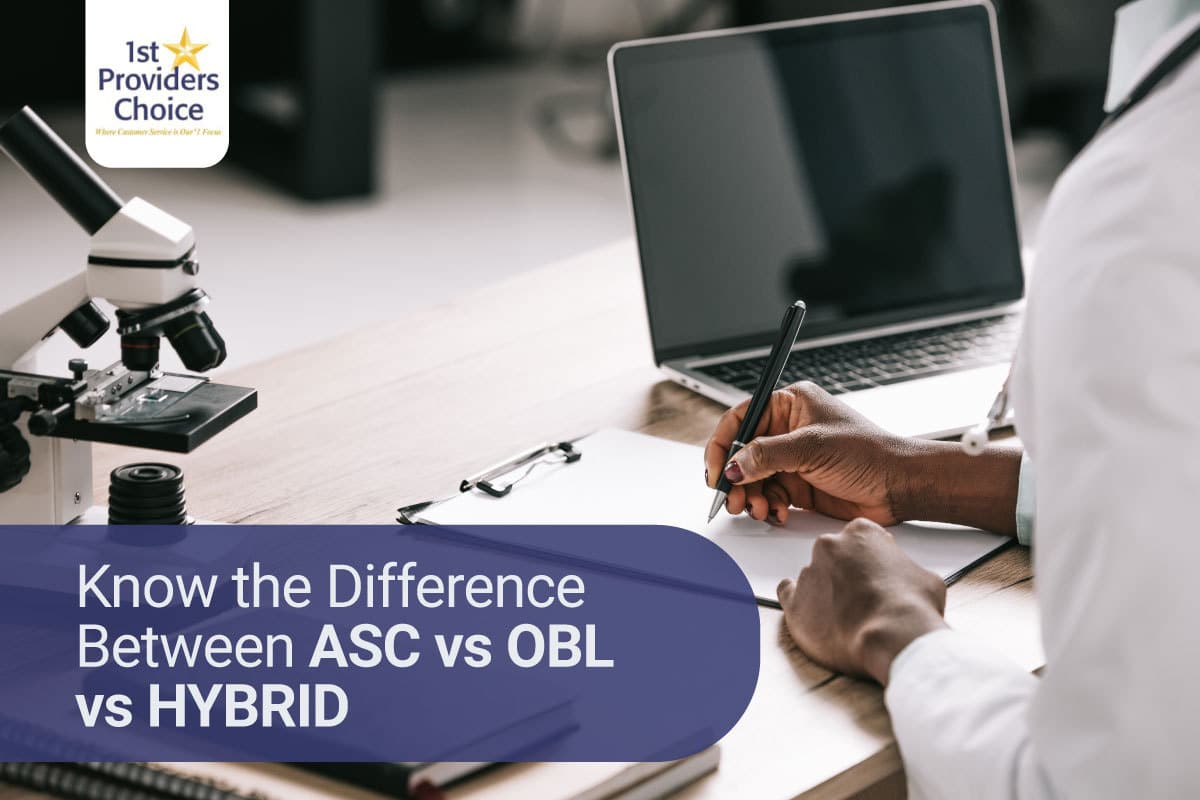Know the Difference Between ASC vs OBL vs HYBRID
Posted by 1st Providers Choice on

The number of office-based labs (OBLs) and ambulatory surgery centers (ASCs) has increased in the outpatient setting. Another emerging trend is the hybrid model, as well. These facilities are also gaining popularity as time goes by.
In this article, we will learn the differences between ASC vs. OBL vs. HYBRID and their roles.
Ambulatory Surgery Center (ASC)
Ambulatory means, typically, “having the ability to walk,” but in the context of surgery, it refers to patients who can leave the hospital immediately after surgery without being admitted. There are various names for ambulatory surgery, including minimally invasive surgery, outpatient surgery, or same-day surgery. Likewise, the term ambulatory surgery refers to a same-day procedure.
Furthermore, ambulatory surgery centers are free-standing facilities with operating rooms, but they are not hospitals. They perform procedures that allow patients to recover at home once the anesthesia wears off to take care of themselves with little to no assistance.
It is easy to mistake ambulatory surgery centers for hospitals, but they are different. ASCs are free-standing facilities, and they have operating rooms, as well. They perform procedures that allow patients to recover at home once the anesthesia wears off to take care of themselves with little to no assistance.
Generally, ambulatory surgery centers connect to at least one hospital in the community, to which patients can be transported if complications occur during or after the procedure.
Office-Based Labs (OBL)
Office-based labs, also known as office interventional suites (OIS), treat certain diseases with the latest technology. Most procedures performed in these facilities are elective, non-emergent, and low-risk. Most endovascular procedures, including angiograms and peripheral interventions, fall under this classification. Opening an OBL offers physicians more autonomy outside the hospital setting, one of the main attractions.
Recently, outpatient centers such as OBLs have been under scrutiny due to new evidence highlighting unusual utilization rates. There is, however, a much larger significance behind OBLs. They provide low-cost, easily deployable care efficiently.
HYBRID Model/Practice
With more cardiovascular procedures moving to ASCs, we have seen a “hybrid” model emerge. A HYBRID combines an OBL and an ASC. The Centers for Medicare and Medicaid Services (CMS) explain the difference between an OBL and an ASC in its Place of Service Code Set.
OBLs offer examinations, diagnostic procedures, and treatment of illness or injury on an ambulatory basis. In contrast, ASCs provide surgical and diagnostic services on an ambulatory basis in a facility other than a physician’s office.
The facility typically operates on rotating days, some days per week as OBL and others as ASC in a hybrid setting. This duality allows for a wider variety of services, such as cardiovascular services. The benefits of having a hybrid model are as follows:
- The hybrid setting is more interesting for existing centers that can handle additional procedures. The facility can offer more cardiology services due to its versatility in operating as either an OBL or an ASC.
- As cardiology procedures shift to outpatient settings, cardiologists have more autonomy and control as they own ASCs and OBLs. Physicians can also increase their practice income by recovering facility fees through the ASC.
Now, let’s know more about their differences:
The table below shows the differences in OBL and ASC reimbursement:
Ambulatory surgery centers have higher reimbursements than office-based labs. Operating costs tend to be higher because of the additional patient safety requirements and the heightened regulations associated with ASCs. The Vascular Disease Management also reports that OBLs are paid a lower total amount for each procedure, but they get the entire payment rather than sharing it with a hospital.
Also, the image below shows the differences in cost between OBL and ASC.
Difference in Billing

Difference in Regulations:

Other differences pertaining to a HYBRID model/practice:
- Retrofitting an OBL to an ASC is expensive.
- From the beginning, build according to ASC specs to be able to upgrade to hybrid as needed.
- Generally, the OBL and ASC cannot both operate simultaneously.
- On some days of the week, hybrid practices operate as ASC and on others days as OBL.
Key Takeaway
Operating as an OBL/ASC Hybrid maximizes the facility’s efficiency and profitability and enhances the customer experience. Moreover, Hybrid models support reimbursement flexibility for procedures, but they also enable physician schedules and facility operations to achieve efficiencies.
Therefore, the decision to operate as both an ASC and an OBL will enable you to use the same staff, optimize supplies, reduce costs, and ensure standardization of processes with positive clinical outcomes.
Providing you with the Best
Choose only the best for your healthcare practice.
At 1st Providers Choice, we understand the need and expectations of our clients for a higher level of performance for billing software and EMR software. That’s why we only offer the top tailored medical billing system and EHR with features that will allow your practice to operate at its optimum potential, save time, and double your revenue.
You can call us at (480) 782-1116 for immediate assistance, or you can schedule a free demo with our experts TODAY.
